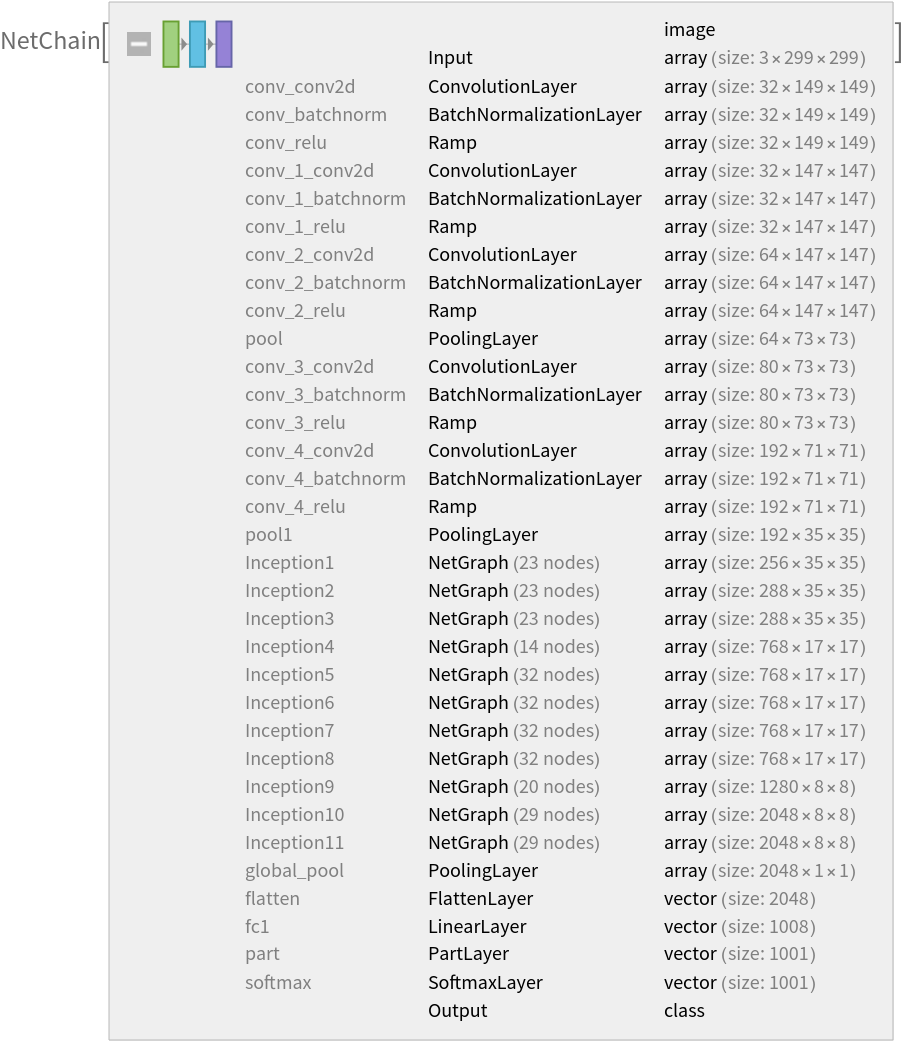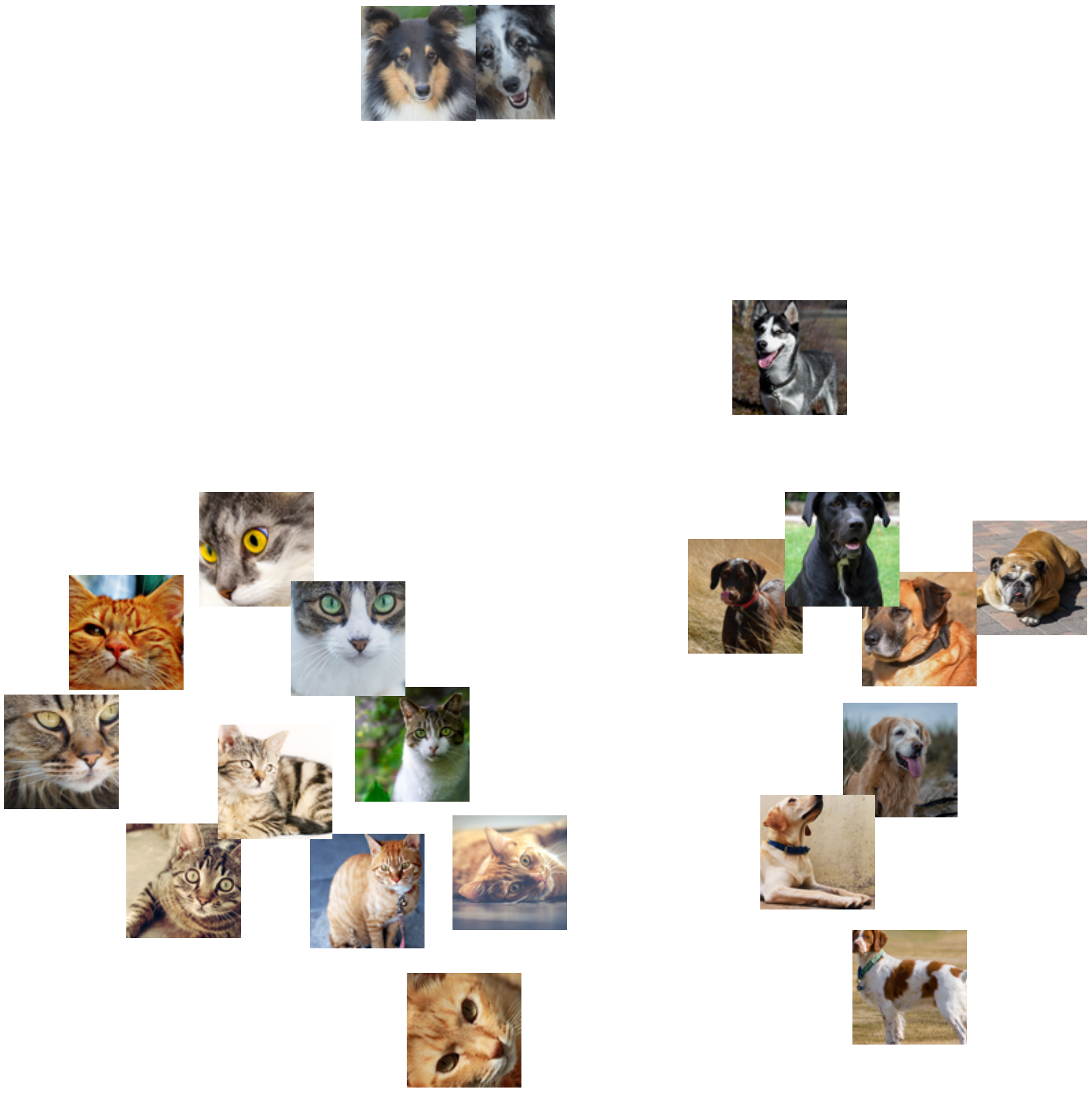Resource retrieval
Get the pre-trained net:
Basic usage
Classify an image:
The prediction is an Entity object, which can be queried:
Get a list of available properties of the predicted Entity:
Obtain the probabilities of the ten most likely entities predicted by the net:
An object outside the list of the ImageNet classes will be misidentified:
Obtain the list of names of all available classes:
Feature extraction
Remove the last three layers of the trained net so that the net produces a vector representation of an image:
Get a set of images:
Visualize the features of a set of images:
Visualize convolutional weights
Extract the weights of the first convolutional layer in the trained net:
Visualize the weights as a list of 32 images of size 3x3:
Transfer learning
Use the pre-trained model to build a classifier for telling apart images of dogs and cats. Create a test set and a training set:
Remove the linear layer from the pre-trained net:
Create a new net composed of the pre-trained net followed by a linear layer and a softmax layer:
Train on the dataset, freezing all the weights except for those in the "linearNew" layer (use TargetDevice -> "GPU" for training on a GPU):
Perfect accuracy is obtained on the test set:
Net information
Inspect the number of parameters of all arrays in the net:
Obtain the total number of parameters:
Obtain the layer type counts:
Display the summary graphic:
Export to MXNet
Export the net into a format that can be opened in MXNet:
Export also creates a net.params file containing parameters:
Get the size of the parameter file:
The size is similar to the byte count of the resource object:

![(* Evaluate this cell to get the example input *) CloudGet["https://www.wolframcloud.com/obj/415d3282-a1fe-496c-8aec-cad3790bc29e"]](https://www.wolframcloud.com/obj/resourcesystem/images/8d8/8d890763-4d74-4f89-90bf-88ef7c60f439/00cdbfab66af8c86.png)

![(* Evaluate this cell to get the example input *) CloudGet["https://www.wolframcloud.com/obj/415dd4b8-e1bd-4123-8cc7-e707e12bdd15"]](https://www.wolframcloud.com/obj/resourcesystem/images/8d8/8d890763-4d74-4f89-90bf-88ef7c60f439/0f43d64c3b38cba6.png)

![(* Evaluate this cell to get the example input *) CloudGet["https://www.wolframcloud.com/obj/db00bb79-8670-4164-b03a-3ac46c75a4a1"]](https://www.wolframcloud.com/obj/resourcesystem/images/8d8/8d890763-4d74-4f89-90bf-88ef7c60f439/25ff3385dbff8a54.png)
![EntityValue[
NetExtract[
NetModel["Inception V3 Trained on ImageNet Competition Data"], "Output"][["Labels"]], "Name"]](https://www.wolframcloud.com/obj/resourcesystem/images/8d8/8d890763-4d74-4f89-90bf-88ef7c60f439/10afa40b891c7667.png)


![(* Evaluate this cell to get the example input *) CloudGet["https://www.wolframcloud.com/obj/5ae68a51-5855-40a8-be29-c99ac268bf88"]](https://www.wolframcloud.com/obj/resourcesystem/images/8d8/8d890763-4d74-4f89-90bf-88ef7c60f439/254f0df5b7af8749.png)


![(* Evaluate this cell to get the example input *) CloudGet["https://www.wolframcloud.com/obj/9d5e3d2b-9eb4-439b-b5ee-b87eb13bfda5"]](https://www.wolframcloud.com/obj/resourcesystem/images/8d8/8d890763-4d74-4f89-90bf-88ef7c60f439/314054b4b6565854.png)
![(* Evaluate this cell to get the example input *) CloudGet["https://www.wolframcloud.com/obj/c11c5429-75e3-4145-b873-2cbc2c59abfa"]](https://www.wolframcloud.com/obj/resourcesystem/images/8d8/8d890763-4d74-4f89-90bf-88ef7c60f439/2d19eba8e4040589.png)

![newNet = NetChain[<|"pretrainedNet" -> tempNet, "linearNew" -> LinearLayer[], "softmax" -> SoftmaxLayer[]|>, "Output" -> NetDecoder[{"Class", {"cat", "dog"}}]]](https://www.wolframcloud.com/obj/resourcesystem/images/8d8/8d890763-4d74-4f89-90bf-88ef7c60f439/3b04376cd5343baa.png)


